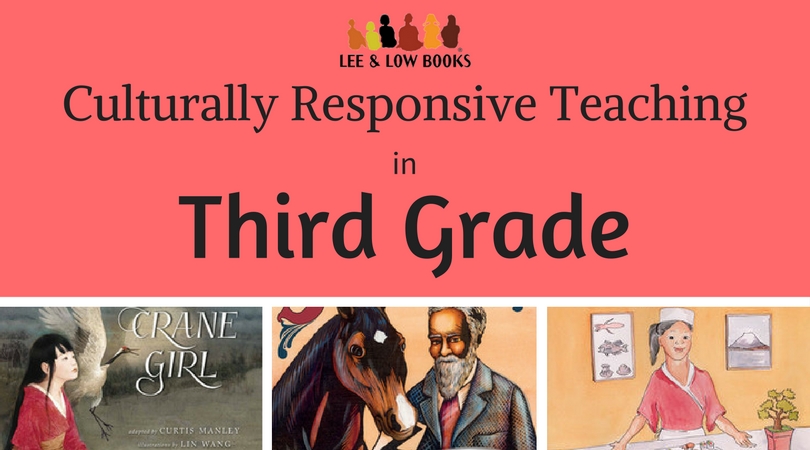In this ongoing series, we explore what culturally responsive teaching looks like at different grade levels and offer concrete examples and resources. Last month we explored bridging the familiar and unfamiliar in literature discussions for second grade. This month, educator Lindsay Barrett offers guidance on culturally responsive teaching in third grade by going beyond “The Single Story”.
More in this series:
- What is Culturally Responsive Teaching?
- Culturally Responsive Teaching in Kindergarten: Read Alouds to Build Relationships
- Culturally Responsive Teaching in Grade 1: Intentional Selection of Texts for Reading Discussion
- Culturally Responsive Teaching in Grade 2: Bridging Between the Familiar and Unfamiliar in Literature Discussions
- How Culturally Responsive is Your Classroom Library?
Nigerian author Chimamanda Ngozi Adichie’s TED talk, The Danger of a Single Story, is a must-see for educators on the importance of cultivating diverse perspectives in young people. Her personal anecdotes caution against letting young people form a one-dimensional perception of groups of people if only provided with limited information. She tells of her childhood view that all book characters were white and ate apples, which persisted until she discovered African authors. She also shares her surprise at the stereotypes her American college roommate had about Africans, since they reflected nothing of her actual life.
Adichie’s words are a call for educators to push beyond a “single story,” a charge that aligns with the tenets of culturally responsive teaching. Diverse books are an obvious place to start, but teachers must ensure they don’t mistakenly limit students’ perspectives with their use of a particular text.
Take, for example, a reading of the Japanese folktale The Crane Girl.  It’s a perfect text to work towards third grade Common Core standard RL.3.2, which asks students to “determine the central message or moral” in stories, including traditional stories from diverse cultures, referring to “key details from the text” in their explanations. The retelling of a traditional Japanese tale depicts a boy who kindly frees a trapped crane. To repay him, the crane takes the form of a young girl who visits the boy’s household and offers to weave silk to ease the family’s financial woes. The boy’s father becomes greedy and when he breaks the girl’s trust, he must face the consequences. Discussions with students can focus on messages about the impact of people’s decisions, including the power of kindness and the perils of greed. The illustrations, descriptive text, and accompanying haiku poems all offer examples of supporting details to which students can refer.
It’s a perfect text to work towards third grade Common Core standard RL.3.2, which asks students to “determine the central message or moral” in stories, including traditional stories from diverse cultures, referring to “key details from the text” in their explanations. The retelling of a traditional Japanese tale depicts a boy who kindly frees a trapped crane. To repay him, the crane takes the form of a young girl who visits the boy’s household and offers to weave silk to ease the family’s financial woes. The boy’s father becomes greedy and when he breaks the girl’s trust, he must face the consequences. Discussions with students can focus on messages about the impact of people’s decisions, including the power of kindness and the perils of greed. The illustrations, descriptive text, and accompanying haiku poems all offer examples of supporting details to which students can refer.
The Crane Girl also presents just one story of Japanese culture. Taken as a “single story,” students may perceive Japan as a land of kimonos, silk, haiku, and rural living. Consider also sharing other stories about Japan and Japanese culture. Explicitly connect these texts to show students how to construct a multi-faceted “story” of a topic. Present a portrayal of life in present-day Japan like The Falling Flowers, which describes the magic of the cherry blossoms in modern Toyko. Also consider Hiromi’s Hands, which chronicles the training of father and daughter sushi chefs, introducing more Japanese traditions. Teach students to seek out authentic voices to inform their perspectives. The Wakame Gatherers is about a young Japanese girl who helps her grandmother harvest seaweed. Author Holly Thompson has lived for many years in Japan and her first-hand experiences shaped the book’s content. The East-West House: Noguchi’s Childhood in Japan is the story of artist Isamu Noguchi. In this video, author Christy Hale talks at length about her research about Noguchi that informed the text and illustrations.
Single stories aren’t limited to portrayal of cultures. It is also in students’ interest to present a variety of examinations of particular themes. There is certainly no “single story” of kindness or greed. Exploring traditional Cinderella stories from around the world alongside The Crane Girl with third graders is an opportunity to consider variations on these themes in a range of different contexts. Or, present a text from a completely different genre that explores similar messages. Step Right Up: How Doc and Jim Key Taught the World About Kindness, a work of literary nonfiction about a veterinarian at the turn of the 20th century, presents an alternate story of kindness that can expand upon conversations initiated by The Crane Girl. Looking at a variety of texts within a given theme is particularly culturally responsive because it gives students options for entry points that resonate with them.
Choosing to share diverse books with your students is a crucial piece of developing a culturally responsive teaching practice. Taking care to present “many stories” with those books, in third grade and all the rest, is an important next step.
 About the Author: Lindsay Barrett is a former elementary teacher and literacy nonprofit director. She currently works as a literacy consultant and stays busy raising three young boys. Find out more about her work at lindsay-barrett.com.
About the Author: Lindsay Barrett is a former elementary teacher and literacy nonprofit director. She currently works as a literacy consultant and stays busy raising three young boys. Find out more about her work at lindsay-barrett.com.









